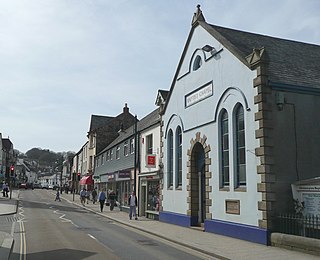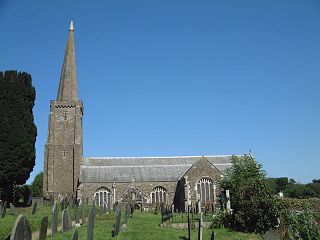Princetown is a village located within Dartmoor national park in the English county of Devon. It is the principal settlement of the civil parish of Dartmoor Forest.

Okehampton is a town and civil parish in West Devon in the English county of Devon. It is situated at the northern edge of Dartmoor, and had a population of 5,922 at the 2011 census. Two electoral wards are based in the town. Their joint population at the same census was 7,500.
Ivybridge is a town and civil parish in the South Hams, in Devon, England. It lies about thirteen miles east of Plymouth. It is at the southern extremity of Dartmoor, a National Park of England and Wales and lies along the A38 "Devon Expressway" road. There are two electoral wards in Ivybridge East and Ivybridge West with a total population of 11,851.

Yealmpton is a village and civil parish in the English county of Devon. It is located in the South Hams on the A379 Plymouth to Kingsbridge road and is about 8 miles (13 km) from Plymouth. Its name derives from the River Yealm that flows through the village. At the 2001 census, it had a population of 1,923, falling to 1,677 at the 2011 census. There is an electoral ward of the same name. The population of this ward in 2011 was 2,049.

South Tawton is a village, parish and former manor on the north edge of Dartmoor, Devon, England. An electoral ward bearing the same name exists. At the 2011 census the population was 1,683.

Belstone is a small village and civil parish in the West Devon District of Devon, England.

Bovey Tracey is a small town and civil parish in Devon, England, on the edge of Dartmoor, its proximity to which gives rise to the "slogan" used on the town's boundary signs, "The Gateway to the Moor". It is often known locally as "Bovey". It is about 10 miles south-west of Exeter and lies on the A382 road, about halfway between Newton Abbot and Moretonhampstead. The village is at the centre of the electoral ward of Bovey. At the 2011 census the population of this ward was 7,721.

Hele's School, formerly Plympton Grammar School, is a mixed Academy school and Sixth Form in the Plympton district of Plymouth, England, 6 miles (9.7 km) east of Plymouth city centre. Until 31 March 2011, Hele’s was a community school funded by the Local Education Authority (LEA), which is Plymouth City Council. From 1 April 2011, Hele's became an Academy, which among other things gives the school financial and educational independence. The school has a voluntary Combined Cadet Force with Navy, Army and RAF sections. Cadets in the CCF are given the option to take part in the annual Ten Tors Challenge on Dartmoor.

Holbeton is a civil parish and village located 9 miles south east of Plymouth in the South Hams district of Devon, England. At the 2001 census the parish had a population of 579, down from 850 in 1901. By 2011 it had increased to 619.

Membury is a village three miles north west of Axminster in East Devon district. The population at the 2011 Census was 501.
Efford is an historic manor formerly in the parish of Eggbuckland, Devon, England. Today it has been absorbed by large, mostly post-World War II, eastern suburb of the city of Plymouth. It stands on high ground approximately 300 feet above the Laira estuary of the River Plym and provides views over long distances: to the north across Dartmoor, to the east and south-east across the South Hams. It consists predominantly of local authority and housing association properties. Before this land was built upon it was known as 'The Wilds of Efford', and was largely unspoilt countryside and marsh land. That a deer park may have been attached to the manor is suggested by the survival of the street name "Deer Park Drive".

Elize Hele (1560–1635) of Fardel in the parish of Cornwood, Devon and of Parke in the parish of Bovey Tracey, Devon, was an English lawyer and philanthropist. In 1632 he transferred his lands into a trust intended for "pious uses", from which charitable action and in order to distinguish him from his many prominent relations, he became known to posterity as "Pious Uses Hele", which his biographer Prince looked upon "as a more honourable appellation than the greatest empty title". The trustees included his wife, together with John Hele and a number of friends. The trust was used to create a number of schools in Devon including Plympton Grammar School.

Dendles Wood is an area of protected oak-beech woodland located on the southern edge of Dartmoor, in the English county of Devon. Forming part of the Dartmoor Special Area of Conservation, the wood is also a Site of Special Scientific Interest, and 30 hectares of it has been designated a national nature reserve. It is one of five woodlands within Dartmoor that have been protected as national nature reserves. Dendles Wood and the adjacent Hawns Wood are sometimes known collectively as Hawns and Dendles. The wood supports a variety of flora and fauna, representative of upland oakwoods. In particular, it has a rich variety of moss and lichen, and several breeding bird species.

George Treby of Plympton House, Plympton St Maurice, Devon, was an English Whig politician who sat in the House of Commons for 34 years from 1708 to 1742. He was Secretary at War from 1718 to 1724, and Master of the Household from 1730 to 1741. He built Plympton House between 1715 and 1720, which his father began and left unfinished at his death in 1700.

Sir John Hele of Wembury in Devon, serjeant-at-law, was a Member of Parliament for Exeter and was Recorder of Exeter (1592–1605). He was one of Prince's Worthies of Devon (1701). He built at Wembury one of the grandest manor houses ever seen in Devon, called by his near contemporary Risdon : "A magnificent house, equalling, if not exceeding, all other in these western parts, for uniform building; a sightly seat for shew; for receipt spacious; for cost sumptuous; for sight salubrious". It was already a ruin by about 1700, and was finally demolished in 1803. He founded a boys' hospital in Plymouth. His monument and effigy survives in Wembury Church.
Flete in the parish of Holbeton in Devon is an historic manor. In 1810 it was called "one of the finest estates in the county of Devon". The present manor house known as Flete House was built in the 19th century incorporating some elements of an earlier Tudor house on the site.

Parke is an historic estate in the parish of Bovey Tracey in Devon, England. The present mansion house known as Parke House, a grade II listed building situated 1/2 mile west of the centre of the town of Bovey Tracey and on the opposite side of the River Bovey, was rebuilt in 1826/8 by William Hole (1799-1859) and is today the headquarters of the Dartmoor National Park Authority.

Fardel is a historic manor in the parish of Cornwood, in the South Hams district of Devon. It was successively the seat of the Raleigh and Hele families. The surviving Grade I listed medieval manor house is situated about half-way between Cornwood and Ivybridge, just outside the Dartmoor National Park on its south-western border.

John Woolcombe (1680-1713) of Pitton in the parish of Yealmpton in Devon, was a Member of Parliament for Plymouth in Devon 1702–5, and served as Sheriff of Devon in 1711–12.
Alexander Frederick Clifford Darwall is a British landowner, hedge fund manager, and millionaire. He is notable for having roles in several large investment companies, his donations to UKIP, the Leave Party, and for his 2022-23 court case where he limited public access to Dartmoor.

















